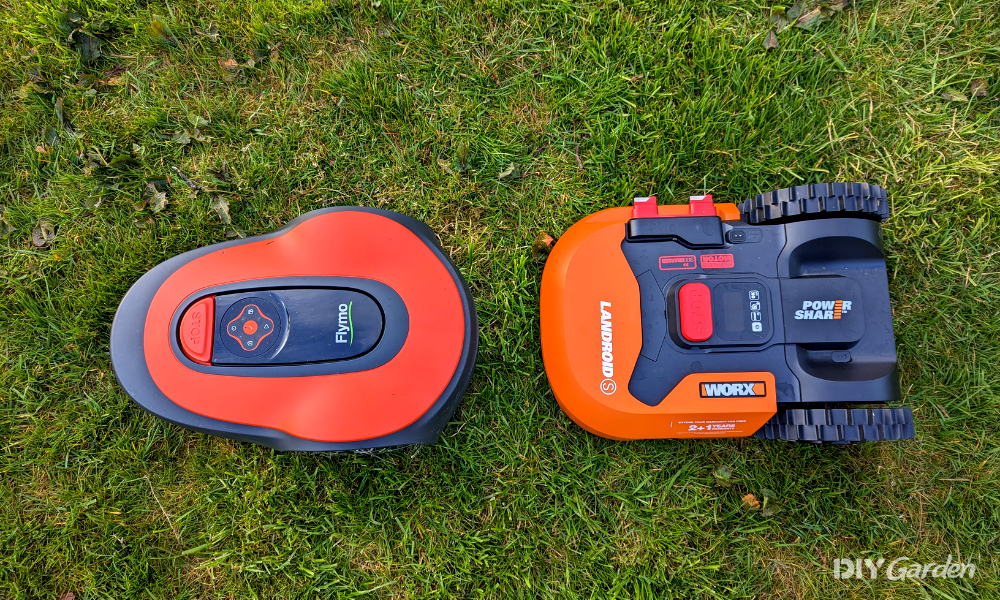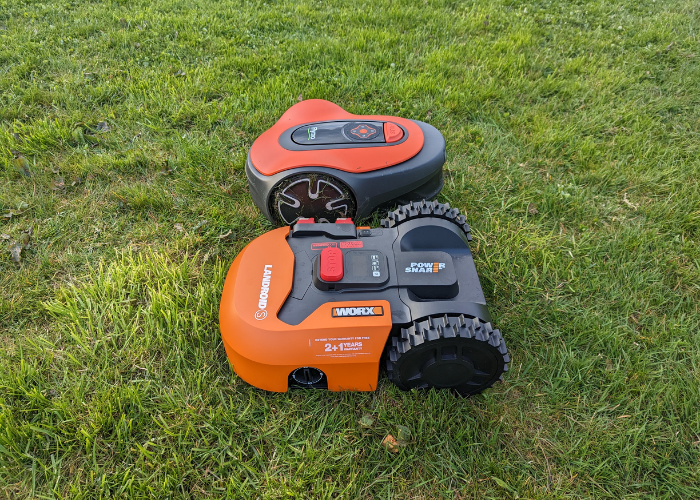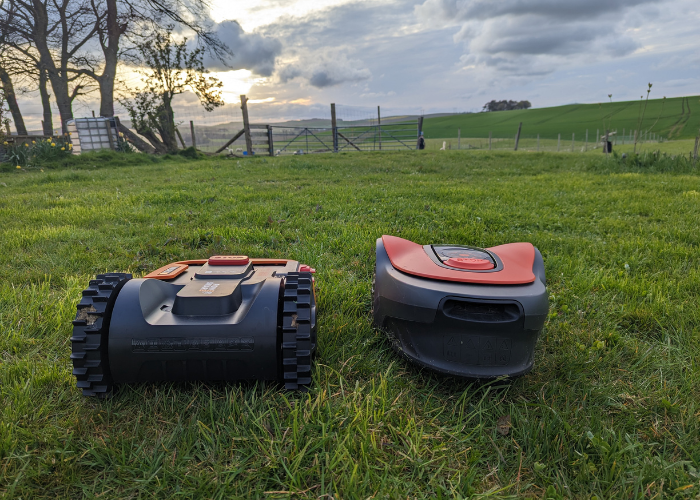
Thinking about treating yourself to a robotic lawn mower? If cutting your grass every week or so isn’t a task that you particularly enjoy, then a robot lawn mower would be a worthwhile purchase. However, with so many different options now available on the market, deciding which model would be best for your lawn can be a little tricky.
Do a search online for the best robotic lawn mower for small gardens and two of the most popular options will be the Flymo EasiLife 150 GO vs WORX Landroid S WR130E. I recently tested out both of these machines and while there are several similarities between them, there are also some major differences that are likely to sway your buying decision.
Setting The Lawn Mowers Up
Winner – Worx Landroid
The setup process for a robotic lawn mower is generally quite standard; secure the base to the ground and then lay the boundary wire. However, there are two aspects to this where the Flymo and Landroid differ.
The first is in positioning the base. The Flymo reverses into its dock, meaning that you can position the base anywhere, including in a corner. However, the Landroid is a side-charging machine. It drives into its dock from one side and then exits from the other, so the base needs a fair bit of room on either side.
Just like any robot lawn mower, both machines rely on a boundary wire. However, the Flymo also requires an additional guide wire. This needs to run from the base to the furthest point of your boundary cable. You’ll also need to lay a guide wire down the centre of any narrow passageways that you want your lawn mower to manoeuvre through. Although this isn’t a huge amount of extra work, it does mean that the Landroid is the better option if you’re hoping for a setup process that’s as simple as possible.
Design
Winner – Worx Landroid
At first glance, both the Flymo and the Landroid look pretty similar. They’re both roughly the same shape and size, and they also both have a vivid orange body. Both machines offer the same cutting height variations too – 20-50mm, although it’s much easier to change the cutting height on the Landroid.
Where they begin to differ is when it comes to cutting width. The Flymo’s is 16cm while the Landroid’s is 18cm. It’s not a huge difference but it does mean that the Landroid is capable of taking off a little bit more of your grass with each pass. That said, this makes sense considering that the Landroid is designed for slightly larger gardens – it can maintain an area of up to 300m², whereas the Flymo’s limit is 150m².
Another notable difference between the two is that the Landroid has an LED screen, whereas the Flymo doesn’t. This obviously has no effect on the performance of the machines, but the Landroid is a little easier to operate because of it.
Power
Winner – Worx Landroid
You’ll need mains electricity for both the Flymo and the Landroid – this connects up to each machine’s base and charges the lawn mower’s battery each time it docks.
The Flymo’s battery is built into the unit. This isn’t an issue as such, although it does make it a little trickier to replace, which you’ll probably need to do after using the lawn mower for a few years.
On the other hand, the Landroid uses an interchangeable WORX PowerShare battery. If you own a battery-powered WORX tool, then you’ll already have one of these batteries. If not, they’re easy to buy, giving you the option of upgrading your lawn mower’s battery. The main benefit to this would be that your Landroid would be able to run for a longer period of time in between charges, meaning that it would get your lawn under control even faster. It would also be capable of cutting an area that’s even larger than 300m², so long as you purchased some extra boundary wire too. Unfortunately, the Flymo’s built-in battery doesn’t offer this flexibility and versatility.
Performance
Winner – Worx Landroid
There isn’t a huge difference between how the Flymo and the Landroid perform.
The Landroid does seem to work a little more efficiently in that it needs slightly less time on the lawn to keep it maintained, but when it comes down to it, they both provide a neat and even finish.
They both also mulch as they cut and are able to handle slopes and bumpy ground. That said, the Landroid can tackle steeper inclines than the Flymo – up to 35% vs Flymo’s 25%.
They both share the same downside too – they struggle with the margin of a lawn that backs onto a raised edge. If your lawn has flat edges, this isn’t a problem, but it’ll mean that you’ll need to strim the edges of your lawn if they’re bordered by a wall, a raised bed, or anything else that the machines would view as an obstacle.
READ NEXT
Features
Winner – Worx Landroid
If basic features are all you’re looking for, then the Flymo and the Landroid are pretty similar.
Both have temperature sensors that keep the machine docked in frosty conditions so as not to damage the grass or the machine. The Landroid has an additional rain sensor too, whereas the Flymo will continue to cut the grass in the rain. This isn’t a bad thing – the machine is light so it leaves no tracks on the lawn, and it hasn’t yet clogged with wet grass.
They both also have an accompanying app with a scheduling feature, plus a few other customisable options.
If you’re looking for a few advanced features on top of that, then that’s where the Landroid shines.
Its AIA Patented Navigation Technology is the reason why the machine doesn’t require a guide wire, and it also means that you can use the app to set invisible fences around certain areas of your lawn. If you wanted the Flymo to circle around an area, you would need to lay down an additional boundary wire.
There are also a few extra modules, such as an Anti-Collision System, that you can purchase separately for the Landroid, which is an option that the Flymo doesn’t offer.
READ NEXT: The UK’s Best Robot Lawn Mower
Safety
Winner – Draw
Both the Flymo and the Landroid come with all of the safety features that a robot lawn mower may need.
They both boast tilt and lift sensors that stop the blades if the machine is lifted. They also both travel at a very slow pace. When they bump into something, it’s gentle and won’t cause any damage.
Both machines are also fitted with a pin number and give you the option of adding a lock and an alarm via the app if you want to protect it further.
Value for Money
Winner – Draw
One big difference between the Flymo and the Landroid is the price, with the Landroid being more expensive. While that may be the case, I would have to say that both machines offer good value for money.
The Flymo may cost a little less, but this is because it’s designed for a smaller lawn and it also has fewer features. However, if a basic robot for a small lawn is all that you’re after, then it’s a great deal!
On the other hand, if you need to maintain a slightly larger lawn and the extra features would be useful to you, then the Landroid would definitely be a worthwhile purchase.
Overall
Winner – Worx Landroid
If your lawn is larger than 150m², then the Landroid would be your best bet. However, if your garden is roughly that size or smaller, then the main difference between the Flymo EasiLife 150 GO vs WORX Landroid S WR130E is the features. The Landroid is more advanced, whereas the Flymo is slightly more basic.
With that being said, the most important thing to judge a robot lawn mower on is its performance. In that area, both machines did an amazing job and have left my grass looking much healthier. So, rest assured that no matter which one you pick, you’ll definitely end up with a beautifully manicured lawn!
READ NEXT: How Does a Robot Lawn Mower Work?


